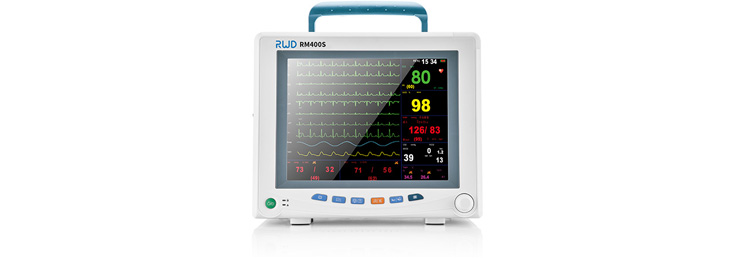RM300 / RM400S / RM400M Veterinary Multi-parameter Monitor
The RWD veterinary monitors are intended for veterinary hospitals or clinics and other special procedures laboratories. Monitorable parameters include SpO₂, ECG, NIBP, TEMP, RESP, ETCO₂.
Technical Specifications:
Size and Weight
318 mm × 264 mm × 152 mm; 4.5 kg
Power supply
Power Voltage AC 100 - 240 V
Frequency 50/60 Hz
Input current 0.6 A - 0.3 A
Fuse T 2 A/ 250 V, integrated in the power module
Earth leakage current < 0.3 mA
Safety class Category I
Display
LCD Size 12.1″
Type Color TFT-LCD
Resolution 800×600 pixels or higher
Indicators
Physiological alarm LED 1(Yellow/Red)
Technical alarm LED 1(Blue)
AC Power LED 1 (Green/Orange)
Battery Charge LED 1 (Yellow)
Interface
Power 1 AC power inlet
Wired network 1, standard RJ45 socket
Equipotential grounding terminal 1
Battery
Rechargeable Lithium Ion battery, 11.1V/4.0 Ah
Charge time ≤ 6 hours (2 batteries for 12 h)
Operating time under the normal use and full charge
≥ 240 minutes (2 batteries for 480 minutes)
New and fully charged battery at 25 ℃ ambient temperature and NIBP work on AUTO mode for 20 minutes interval.
Operating time after the first alarm if low battery ≥ 10 minutes
SpO2
BLT-SpO2
Measurement Range 0 ~ 100 %
Resolution 1 %
Accuracy
At 70 ~ 100 %, ± 2 %
At 0 ~ 69 %, unspecified
Data update period <13s
Alarm User-selectable upper and lower SpO2 limits
PR
Measurement Range 25 ~ 250 bpm
Resolution 1 bpm
Accuracy ± 1 % or ± 1 bpm, whichever is greater
Data update period < 13 s
Alarm User-selectable upper and lower pulse rate limits
EtCO2 (Sidestream,BLT)
Measure method Infrared spectrum
Measure mode Sidestream
Measurement Range 0.0 ~ 13.1 % (0 ~ 99.6 mm Hg)
Resolution 1 mm Hg
Unit %, mm Hg, kPa
Accuracy
At 2,± 0.3 % (± 2.0 mm Hg)
At ≥ 5 % CO2, < ± 10 % of reading
Range of respiration rate measurement 3 ~ 150 rpm
Calibration Offset calibration: auto, manual
Gain calibration
Range of alarm 0.0~13.1 % (0~99.6mmHg), continuously adjustable between upper limit and lower limit
Alarm indication Sound and light indication
EtCO2 (Mainstream,CAPNOSTAT5)
Measure method Infrared spectrum
Measure mode Mainstream
Warm up time Capnogram displayed in less than 15 s, At an ambient temperature of 25 ℃ , full specifications within 2 minutes.
CO2 Measurement Range 0 ~ 19.7 % (0 ~ 150 mm Hg)
CO2 Resolution 1mm Hg
CO2 Accuracy 0 ~ 40 mm Hg, ± 2 mm Hg
41 ~ 70 mm Hg, ± 5 % of reading
71 ~ 100 mm Hg, ± 8 % of reading
101 ~ 150 mm Hg, ±10 % of reading Temperature at 35 ℃.
CO2 Stability Short-Term Drift: Drift over four hours ≤ 0.8 mm Hg. Long-Term Drift: Accuracy specification will be maintained over a 120 hours period.
Rise time < 60 ms
unit %, mm Hg, kPa
Respiration Rate Range 0 ~ 150 rpm
Respiration Rate Accuracy ± 1 rpm
Alarm indication Sound and light indication
Recorder (optional)
Type Thermal dot array
Paper width 50 mm
Recording waveform Single track, 3 tracks
Recording speed 12.5 mm/s, 25 mm/s, 50 mm/s
Ordering Information:
| Cat No. | Product Description |
| RM300 | Veterinary Monitor with SpO₂, ECG, RESP, NIBP,TEMP and HR |
| RM300 | Veterinary Monitor with SpO₂,ECG, RESP, HR, NIBP, TEMP, and EtCO₂ (Mainstream) |
| RM400S | Veterinary Monitor with SpO₂, ECG, RESP, HR, NIBP, TEMP and EtCO₂ (Sidestream) |
About RWD Anesthesia
RWD Life Science has been always dedicated to study and provide perfect and competitive inhalation anesthesia systems that have great practical value to the life science research community. Multiple complete solutions to different procedures in mice, rats, rabbits, cats, dogs, monkey, pig etc. have been set up, which has remarkable and even exclusive advantages over existing system, for example:
- Precise and stable control of anesthetic agents output regardless of environmental changes like pressure, temperature and air flow within the specific limits.
- The miniaturized design like anesthesia machines and scavenging system helps to improve laboratory space utilization.
- Unique stereotaxic frame nosecone masks and cone masks with tiny sizes satisfy more delicate surgeries like craniocerebral and ophthalmological surgery, and at the same time minimize harmful exposure to the research subjects while connecting to evacuation system.
- The latest-designed waste gas evacuation system with weighing (Cat No.R546W) brings research subjects great convenience.
- Higher performance to price ratio helps research subjects to reduce their expense while maintaining successful research.
- High adsorption efficiency of activated charcoal filter canister (Cat No.R510-31 & R510-31S).
Advantages of Inhalation Anesthesia:
- Can offer an improved level of control over depth and duration of anesthesia, especially for prolonged procedures.
- To be relatively insoluble and faster elimination in blood enables rapid recovery.
- Be of rapid onset and offset with minimal side effects.
- Have little or no toxic effects thanks to non-metabolism characteristic of Sevoflurane and Isoflurane.
- Be more safer and efficient performance to reduce morbidity rates and increase the chance for successful outcomes.





